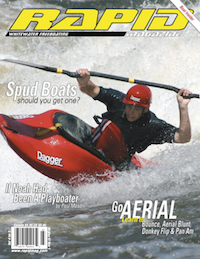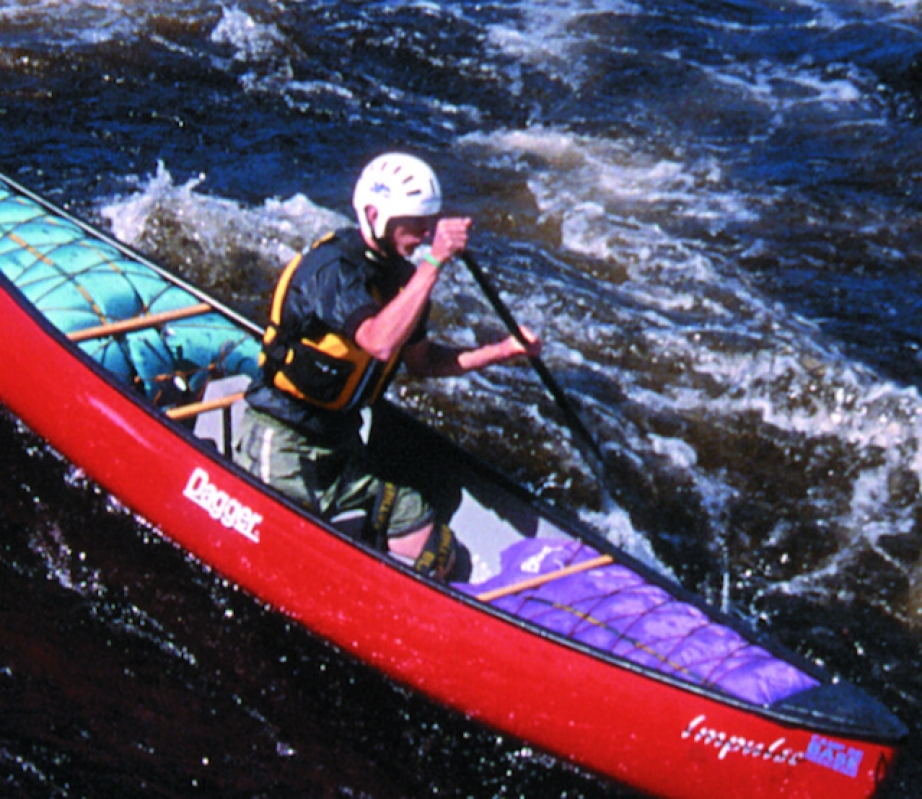Forty days and forty nights without having to shuttle would have been swweeet. Instead, Noah pretty much set the design standard for displacement hull boats. Good or Bad? It all depends on your perspective.
I’ve spent the last few years convinced and trying to convince everyone else that short, planing hull whitewater canoes are best. Period. Well, maybe I’m getting soft but there may actually indeed be merit to those honking big, twelve foot solo boats.
The objective of a planing hull is to surf on top of the water rather than in it. The faster the wave the less displacement there will be and therefore the looser the boat will feel. Small planing hull canoes such as the Dagger Aftershock or Pyrahna Spanish Fly have very flat bottoms.There is no rocker in this flat section. Instead, near the ends of the boat, the hull breaks away abruptly, slanting up to meet the deck at the end of the canoe. This allows the boat to slide to a sideways position on a wave rather than carve across it. The bottom of the hull is actually concave at the sides making a very sharp chine. This is referred to as a release edge. It makes the hull feel loose when sideways on a wave.
The goal of a displacement hull canoe like the Dagger Phantom, Ocoee and every other open canoe out there is completely different. Some canoes such as the Esquif Detonator have flat bottoms but also have rocker, so are still displacement hulls. A displacement hull tracks well, meaning it is resistant to turning.These boats cut through the water making them fast but they must carve their turns to some degree.This ten- dency to travel in a straight line will be affected by rocker, length and chine. Rocker increases a boat’s turning ability as does a shorter length and harder chines.
Since the big flood, canoes have been fairly multipurpose. Sure, some are better at one facet of canoeing than another, but at least each canoe design had the possibility to perform all the manoeuvres that were known as canoeing. As canoe designs changed it was reasonable to expect that they were generally improving, becoming more manouvreable and lighter. Eventually, planing hull technology was incorporated into an open canoe. This would have happened a lot sooner if Noah had built a flat bottom scow instead of a displacement boat. Suddenly, a whole host of new techniques and manoeuvres were achievable in a canoe. Unless you had to move a whole lot of animals, why would anyone want to paddle something that resembled the ark?
Well there are a couple of reasons. Big boats track well, have good hull speed and are really good at punching holes. If you watch one plowing through a hole you can see the stern of the boat sinking into the green water of the downstream current as the bow pierces the hole. This downstream current pushes the canoe through the foampile. Compare that to a short boat that has to climb up the face of the hole. If the stern is still in the green water, the boat will be at such an angle that the current is actu- ally pushing the stern down. Backender!
Big canoes make rapids and waves seem smaller. I’m guessing the Ark was really big. Their large size, buoyancy and speed allows them to plow through many obstacles that a shorter, more manouvreable boat would have to dance around. Some of the highest boofs I’ve heard of an open canoe attempting were done in big 14 foot solo boats. Kind of the same rational that makes a big car safer in a crash.
WE NEED MORE THAN ONE WHITEWATER PLAYBOAT
So now there are two distinct kinds of whitewater canoes vying for a paddlers attention, roofspace and bankbook— planing hull and displacement hull canoes. Typically what happens is a canoeist wears out or outgrows their old displacement boat. They start thinking about a new boat. Which one is best? They try a few and using experience as criteria determine that the new plastic planing hulls are ugly, slow and wet. No argument from me on those points. It is true that short, flat planing hulls are slow on flatwater. But if I wanted to enjoy the flatwater, I’d paddle a flatwater boat! Now I must admit that if there is flatwater involved and you’re the only one in a freestyle playboat, then a faster displacement boat might be okay.
Most freestyle canoes are wet to paddle, meaning water splashes in more easily than in those massive 13 foot super-tankers. When freeboating, taking onwater is fairly irrelevant since each ride in a hole or on a big wave leads to emptying the boat anyway. Who cares whether you’re emptying a little water or a lot. The only difference is that the small boats are light and easy to empty quickly. If your goal is to stay dry as you descend the rapid, go and buy a short displacement canoe with a bulbous nose that will ride over every wave. It will be great for all those front surfs and eddy turns.
So why are canoeists satisfied with displacement hulls? Kayakers moved on to new and exciting possibilities years ago. First time kayakers who just got their new boat and haven’t even taken the price tag off yet, are working towards doing moves with killer names like blunt, donkey flip, tricky whu and pan am.Your average experienced canoeist is still trying to nail a back surf. Maybe canoeists don’t want to do flat spins on a wave because their displacement hull boats aren’t designed to do that. Or are the canoes not designed to do spins because canoeists don’t know they can?
The answer just might be to admit that we need more than one whitewater playboat. A displacement boat for those occasions when you don’t want to play the river, you just want to run it. And a planing hull canoe to open up new learning opportunities and add fresh excitement to your favourite local rapids.
Paul is a Team-Dagger paddler, freelance cartoonist and wishes to sincerely apologize to his father, the late Bill Mason, for not mentioning the prospector canoe in a previous article.
 This article first appeared in the Fall 2002 issue of Rapid Magazine.
This article first appeared in the Fall 2002 issue of Rapid Magazine.




